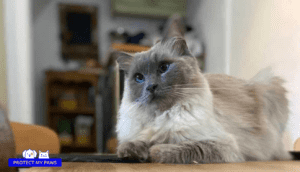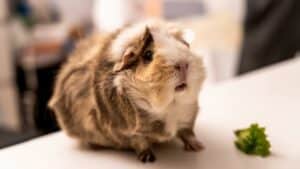| TL;DR: Cat pregnancy typically lasts for 61 to 72 days. Initially, pregnancy signs may be subtle, but they become more evident around the sixth and seventh week. During the seventh week, the queen displays nesting behavior as she prepares for the impending birth. Ensuring that all the kittens start nursing soon after birth is crucial, as the mother’s milk contains vital antibodies to support their early immunity. The kittens typically open their eyes around seven to 10 days old, marking an opportune time to introduce yourself and initiate socialization for their healthy development. |
Discovering that your cat is expecting kittens can surprise many pet owners.
Sometimes, the signs of pregnancy are so subtle that you may have mistaken your cat’s growing belly for a few extra treats. It’s not uncommon to find out about the pregnancy only when a litter of adorable kittens arrives.
Caring for a pregnant cat can be tricky, as they are typically independent creatures. However, providing the proper support is essential during this particular time.
In this article, we will cover everything you need to know about cat pregnancy and birth, from identifying the signs of pregnancy to understanding the duration of the pregnancy. You’ll also learn about their nutritional needs, the different stages of labor and how to care for those precious newborn kittens.
Let’s get started.
How Long Does Cat Pregnancy Last?
Cat pregnancies are pretty brief and zoom by in just about two months. An average gestation period can range from 61 to 72 days within that time frame.
With such a speedy timeline, cat parents have nine weeks to prepare before a bundle of cute kittens takes center stage. But here’s the catch: unless it was a planned pregnancy or
you know for a fact your queen (a mature female cat) mated, determining if she is pregnant can be tricky — especially during the first couple of weeks when there are few visible signs.
However, pregnancy signs will become more apparent as the gestation period progresses. Pet parents often find themselves unexpectedly dealing with a pregnant cat, so quick planning and preparations may be necessary.
So, let’s explore the signs to look out for during each stage:
???? Weeks One To Three:
In the first two weeks, signs of pregnancy may not be evident as it takes about ten days for the egg to be fertilized and implanted into the cat’s uterus. However, by week three, the kittens start developing and the first pregnancy sign may appear: the ‘pinking’ (becoming pinker in color and more visible) of the nipples.
???? Week Four:
At week four, the queen’s hormones are at their peak, which results in new pregnancy signs. Like humans, cats can experience morning sickness now — although this should not cause any weight loss. Instead, the body weight should increase, even though it may not be easily noticeable at first. Also, during this time, it’s best to avoid lifting her to ensure her safety and that of the kittens.
???? Weeks Five to Six:
You’ll likely notice significant weight gain and a rounder tummy by this time. The kittens will be large enough for the vet to feel them and estimate the number of kittens she’s expecting. At this stage, a pregnant cat will have an increased appetite as she starts to gather the necessary nutrients for nursing her kittens.
???? Week Seven:
Around week seven, your pregnant queen starts exhibiting nesting behavior, searching for a cozy and secure place to give birth. You can provide her with a warm, quiet area with soft blankets. However, don’t feel bad if she chooses a different spot; cats have their preferences. Avoid forcing her into a specific nesting box to prevent unnecessary stress.
You may also notice mood changes during this time, with some cats becoming more affectionate while others display occasional assertiveness. Additionally, pregnant queens may sleep more as they carry the extra weight.
| Pro Tip: Creating a nesting place for your cat doesn’t have to be fancy. Cats have a knack for choosing unique spots to have their kittens, from cupboards to under beds and even in sheds. A simple cardboard box lined with soft towels for them to snuggle into will do the trick. Just ensure no pockets or folds could accidentally wrap up the kittens. |
???? Week Eight:
By week eight, you will be able to observe the kittens’ movements on the mother’s tummy. She will groom herself more, which may lead to some fur loss on her belly. This is normal behavior and helps the kittens nurse more quickly after birth. Besides, the fur will grow back once she finishes nursing. Swollen nipples and milk production may begin this week, particularly if she has had a litter before. Otherwise, it may happen in the following week.
???? Weeks Nine and Ten:
Some cats may give birth during week nine, while others may deliver later. Breed and litter size can influence the timing of labor. If the kittens have yet to be delivered by the end of week ten or you have any concerns, contact the vet.
Signs of restlessness, nesting and seeking attention are expected during the last week. A slight red-colored discharge around the vulva is normal and indicates the approaching delivery.
| ???? Feline fact: Unsprayed female cats can get pregnant at a young age and in their senior years. They become sexually mature around four to six months after their first heat cycle. Unlike humans, cats don’t go through menopause, so they can conceive throughout their entire lifespan. |
What Happens During a Normal Cat Birth?
Once labor commences, it is typically a swift and uncomplicated process, especially for queens with prior birthing experience.
It encompasses three different stages:
Stage One:
This is when the process begins, lasting anywhere from a few hours to a whole day. During this time, queens may get restless, groom excessively, pace around and pant. No visible contractions just yet, though. As stage one wraps up, the queen will likely settle into her nest, purring loudly and scratching around to prepare the box. It is also normal for the cat’s temperature to drop from 101 or 102.5F to 98 to 99F.
Stage Two:
Stage two involves the actual delivery of the kittens. The first kitten might take a bit longer as it helps open the cervix fully for the others to follow. The queen may give birth standing, lying down, or squatting. Once delivery begins, kittens are generally born every 30 to 60 minutes, with pauses in between, although it can be faster. If there’s a pause longer than four hours, though, a quick call to the vet is a good idea.
Kittens are born in individual sacs filled with amniotic fluid. After each one is delivered, the mother will swiftly remove the sac from the kitten’s face and cleanse herself and the birthing area.
| Pro Tip: Do not attempt to move her and the kittens to a “better” nest spot after labor has started. This may induce stress, potentially interrupting the labor process or even causing the queen to neglect the litter. |
Stage Three:
Stage three involves the delivery of the placenta right after each kitten is born. Usually, the membranes from each kitten are passed right after their delivery. However, in some instances, a subsequent kitten may swiftly follow, simultaneously delivering two sets of placenta afterward.
| Pro Tip: While it’s common for the queen to eat the placenta, it is also okay if she doesn’t. She might be too busy caring for her kittens to worry about it. Larger litters can make it difficult for the queen to eat them all, and after a few deliveries, she may lose interest in them. Either way, indoor cats don’t need to eat their kitten’s placenta. She will receive plenty of nutrition from her regular meals, and there’s no risk of predators in a home environment. |
Newborn Kittens — What To Expect And How To Care for Them
Once your cat has given birth, there are two essential tips to ensure Mum is ok and the kittens get the best start in life.
1. Give the mother space
After birth, your cat will instinctively know how to care for her newborn, so it’s best to give her space to focus on motherhood. It’s important to watch closely and ensure your queen and the babies are happy and healthy.
Nursing should start right away after birth, mainly for two reasons. Newborn kittens haven’t yet developed the ability to regulate their body temperature, so they need their mother’s warmth to thrive.
On the other hand, the milk of the first days is quite a special one. It is called colostrum and is rich in nutrients and hormones for the kittens’ development; it also contains antibodies that will provide immunity and protection from certain diseases for several weeks until their immune systems work correctly.
During the first two or three weeks after birth, kittens depend entirely on their mother for their basic needs. They rely on her not only for feeding but also for assisting with their urination and defecation. The mother stimulates these bodily functions by licking the belly and genital area, known as anogenital grooming. Through this gentle grooming, she induces elimination. Once the kittens have successfully relieved themselves, the queen will clean up.
| Pro Tip: If you notice not all kittens are receiving colostrum or struggling in any way to get enough milk, contact the vet. Underfed kittens tend to cry and constantly seek the teats. However, if they don’t seem to grow at the same pace as the other kittens or you rarely see them feeding, then that also indicates they might need some assistance. |
2. Don’t hold the kittens right away
While you may be tempted to pet and hold the kittens (we totally understand), avoiding too much intervention in their first week or two is best. During this time, kittens are more vulnerable to diseases and handling them could stress both the mother cat and her babies.
The kittens typically open their eyes around seven to 10 days old and this is a great time to introduce yourself and start socializing with them. Building positive interactions with humans early on helps them become comfortable in our presence.
When they reach four weeks, the kittens begin to use the litter box, observing and learning from their mother’s example. Around this time, the mother cat gradually starts weaning them off her milk and the kittens can be progressively introduced to solid food under the guidance of a vet.
At approximately six weeks, the kittens become more independent, grooming themselves and each other, forming strong bonds.
| ???? Kittens Fact Sheet At birth, kittens weigh approximately 100g, but their weight doubles within a week and triples within three weeks. Kittens are born with their eyes closed, their ears folded and no teeth. Their deciduous baby teeth emerge when they are around two to three weeks old. Newborn kittens need to feed every two to three hours. They spend most of their time sleeping and snugging around their mother and siblings. To stimulate milk flow from their mother, kittens knead on their stomach with their paws. This instinctive behavior is similar to the kneading motion they may display on our laps or their favorite blanket. Kittens tend to return to the same nipple to feed. This behavior helps prevent conflicts among the littermates and ensures a steady milk supply. Besides, by sticking to their preferred spot, they demand the mother cat’s body to keep producing milk. |
Final Thoughts
Cat pregnancy is a short but significant period. As independent creatures as cats are, understanding the signs and process helps you provide proper care for your queen and her kittens. Create a cozy environment, offer a balanced diet and consult your vet for guidance.
Be prepared for the delightful chaos as the kittens grow older and unleash their mischievous side. They’ll pounce on toys with endless energy, knock things over during their playful explorations and embark on imaginary hunts. Their insatiable curiosity will lead them to explore every nook and cranny.
Rest assured, you’ll have plenty of entertainment and never a dull moment!
| SOURCES Cats Protection (2023). Pregnant cats, birth and care of young kittens. Cats.org.uk Davidson, A. P. (2022) Labor and Delivery in Dogs and Cats. msdvetmanual.com Gollakner, R. (2023). Colostrum. vcahospitals.com Little, S. E. (2012). Female Reproduction. nih.gov Shaw, H. (2023). Kitten Development: Understanding a Kitten’s Major Growth Milestones. petmd.com Williams, K. & Ward, E. (2023). Pregnancy and Parturition in Cats. vcahospitals.com |





